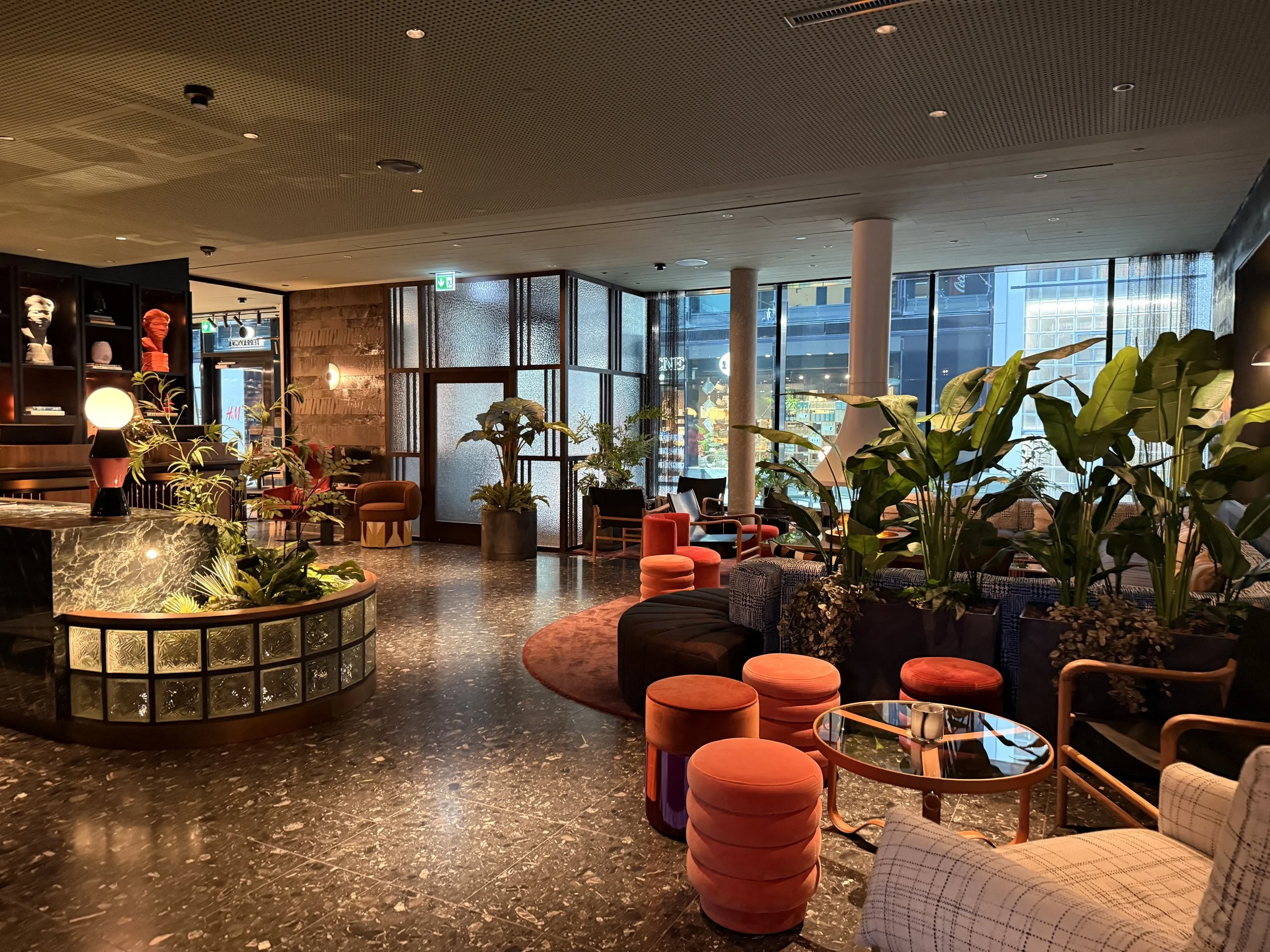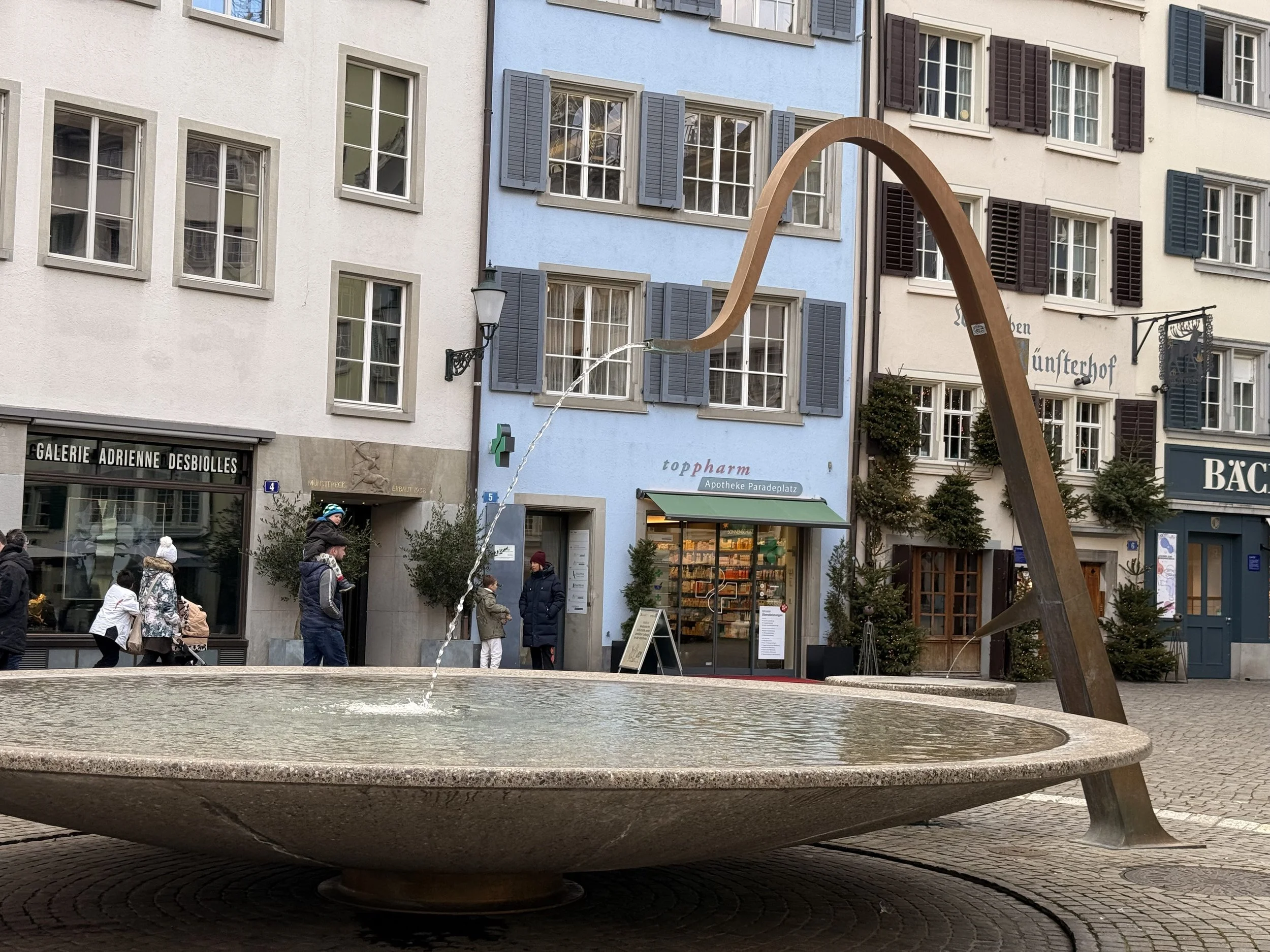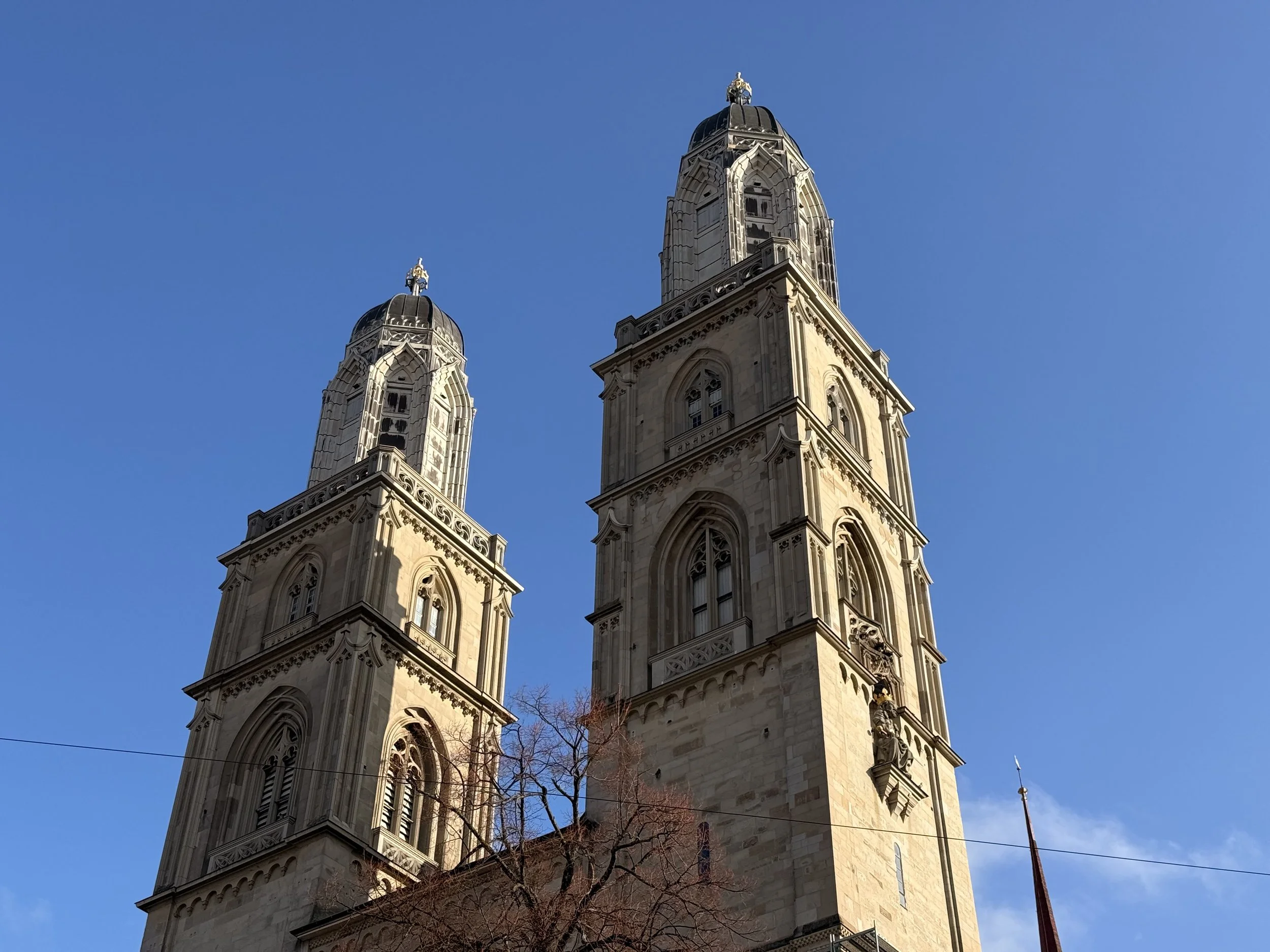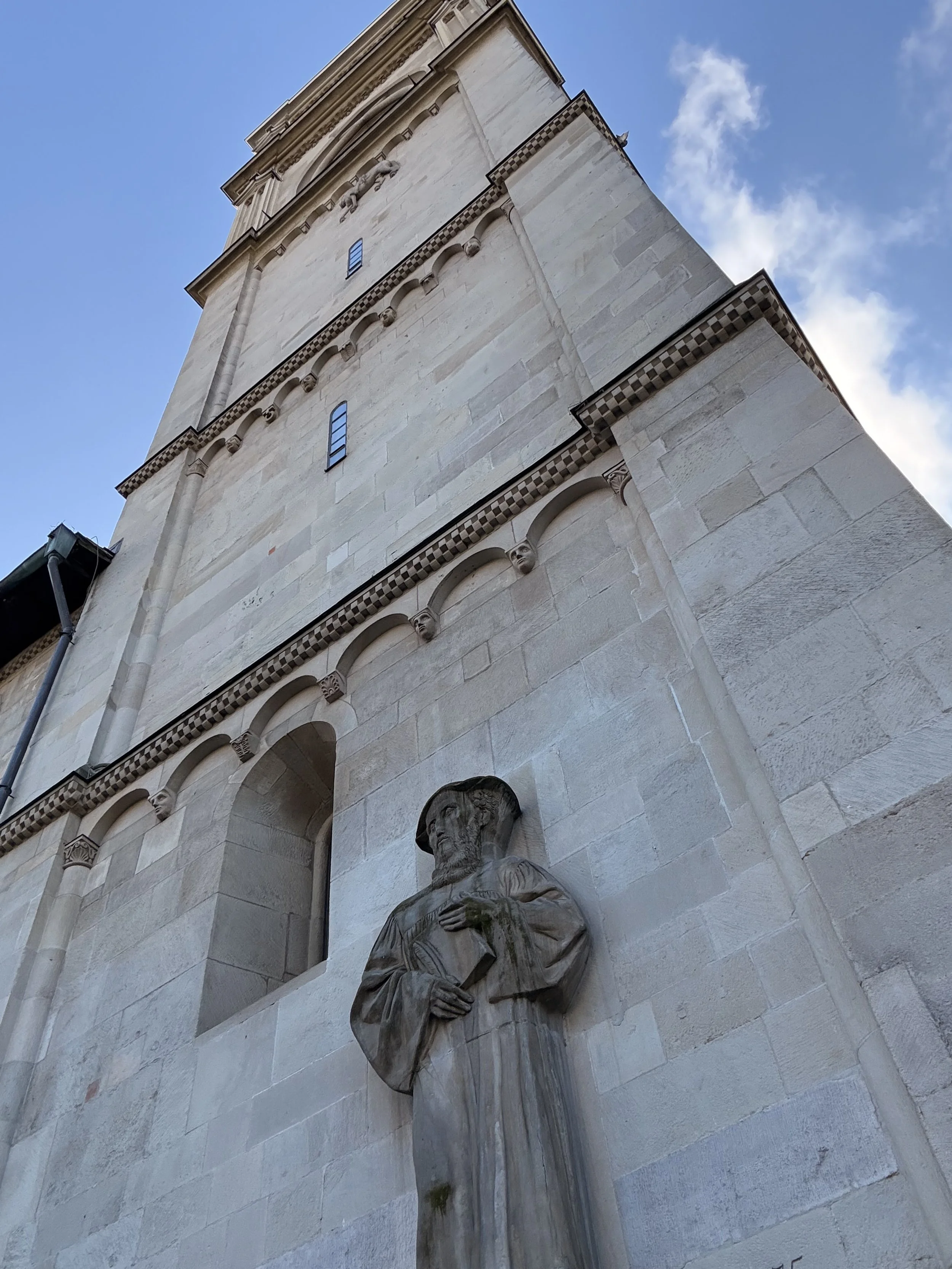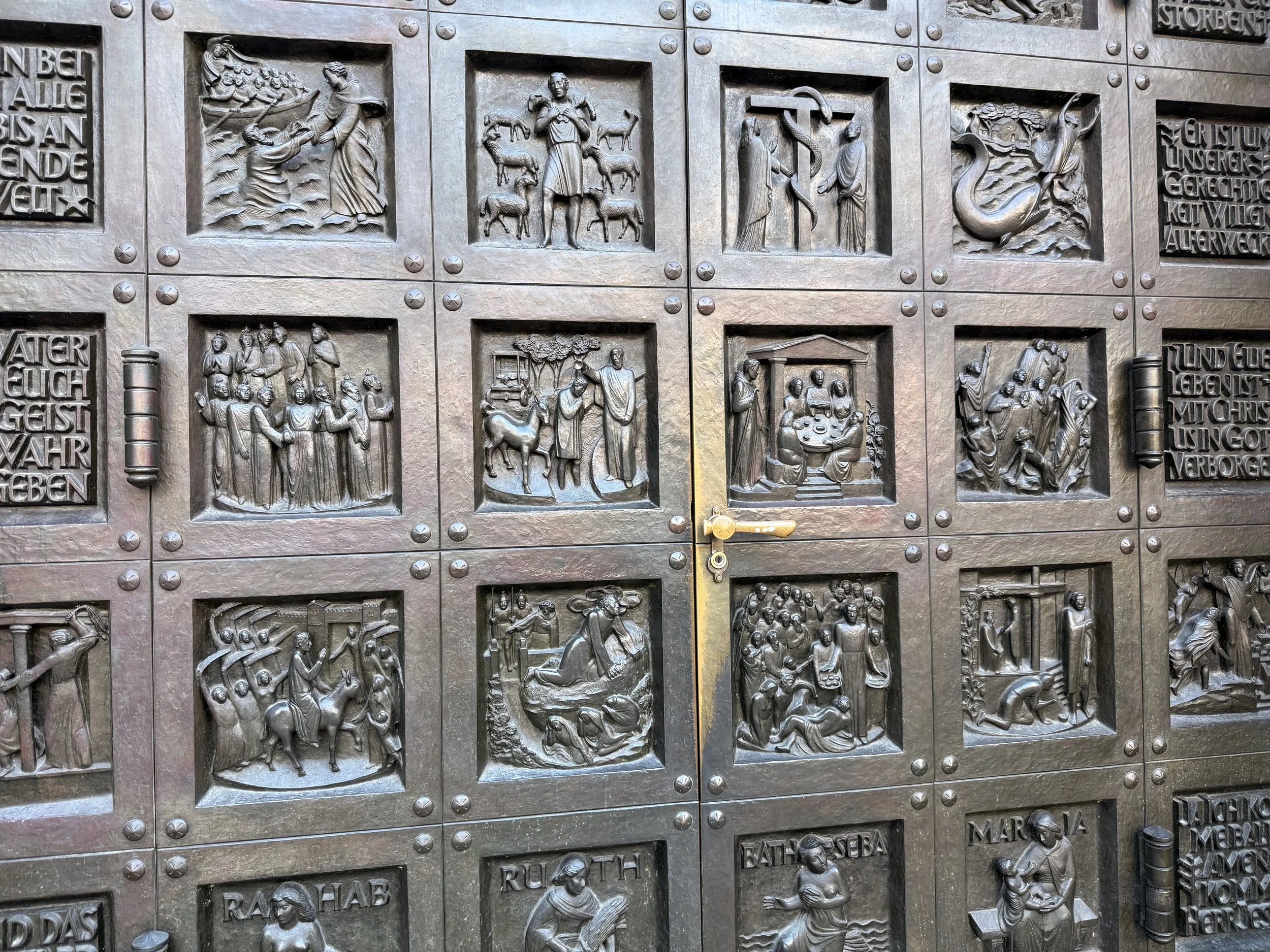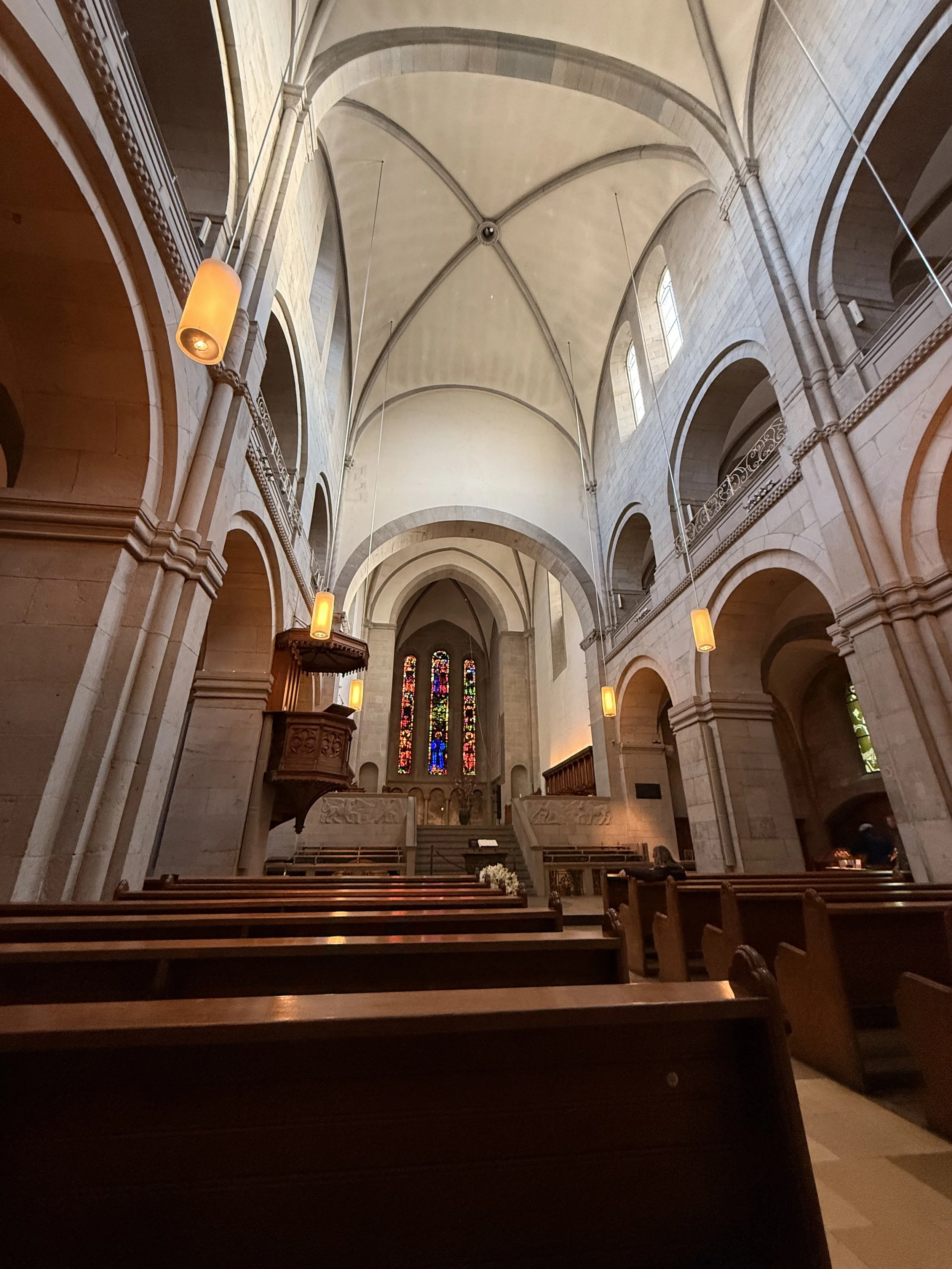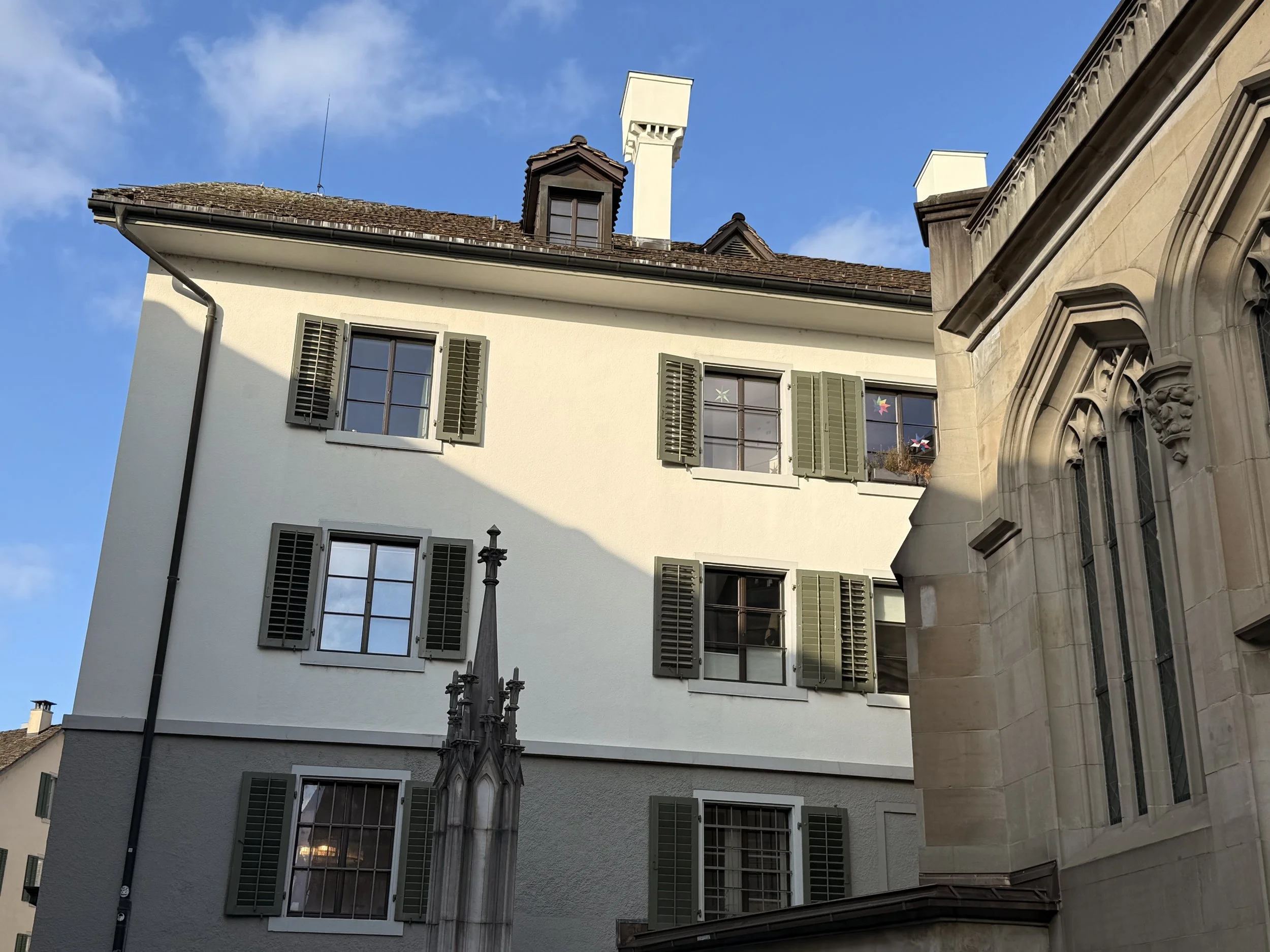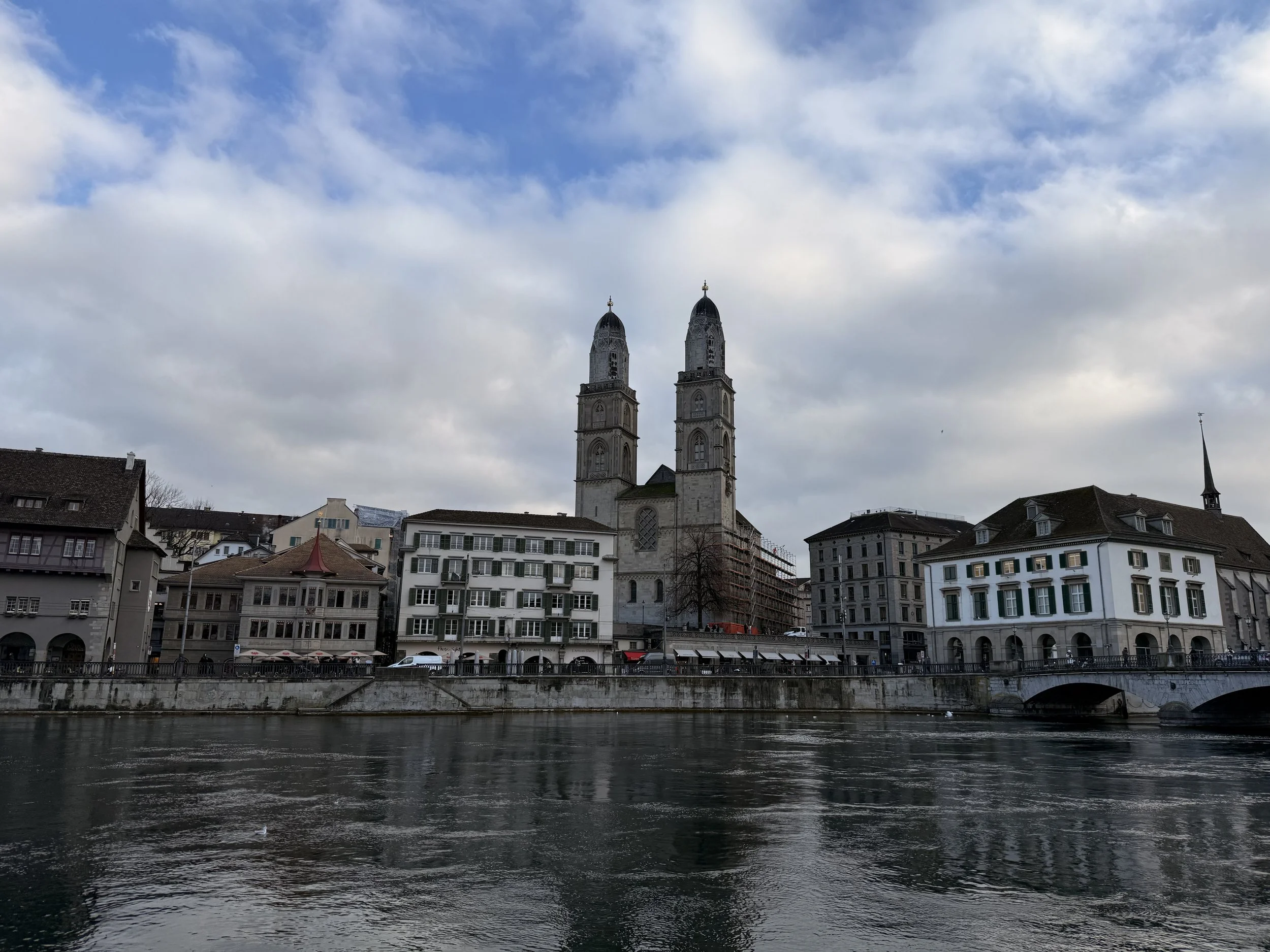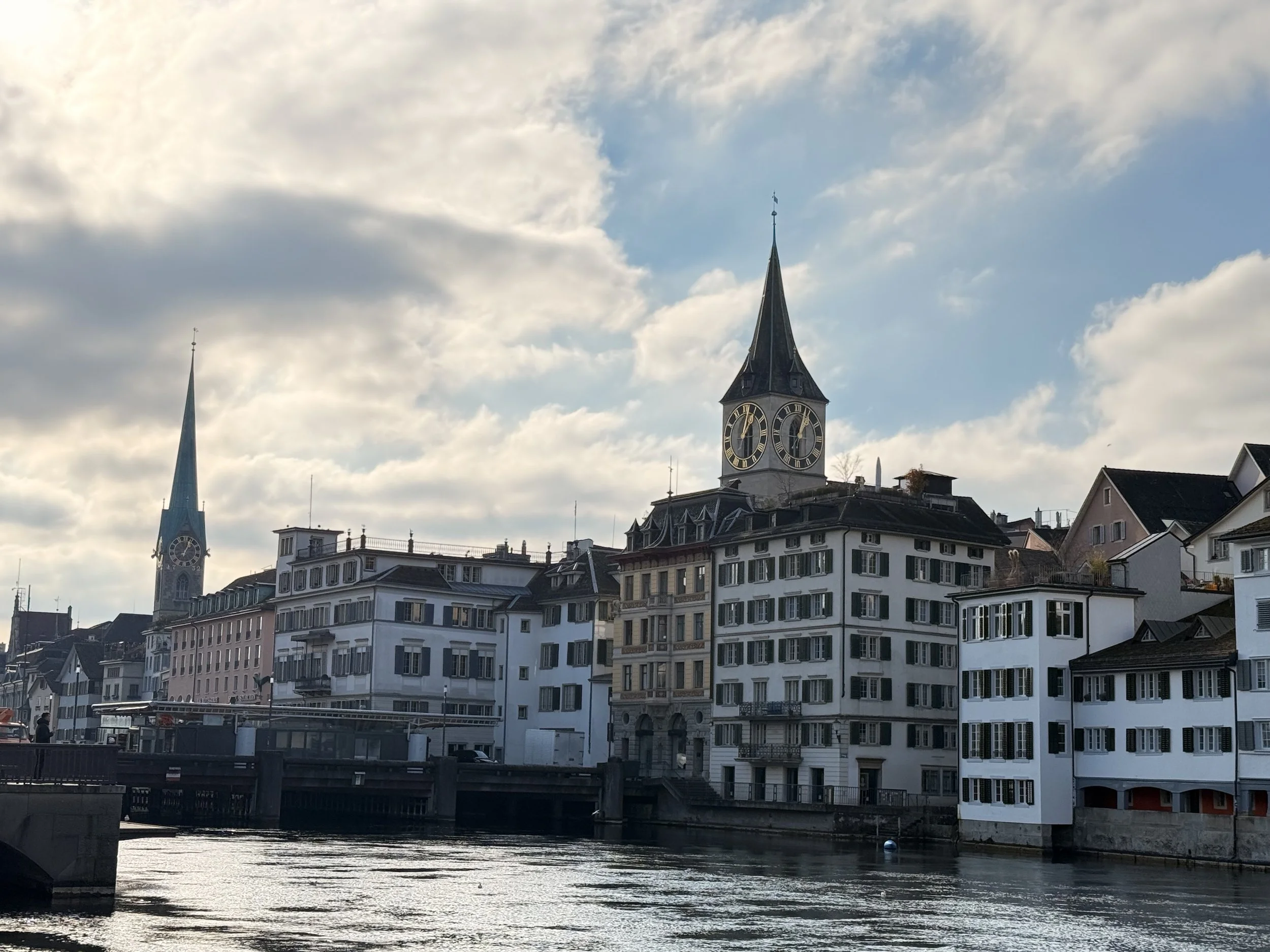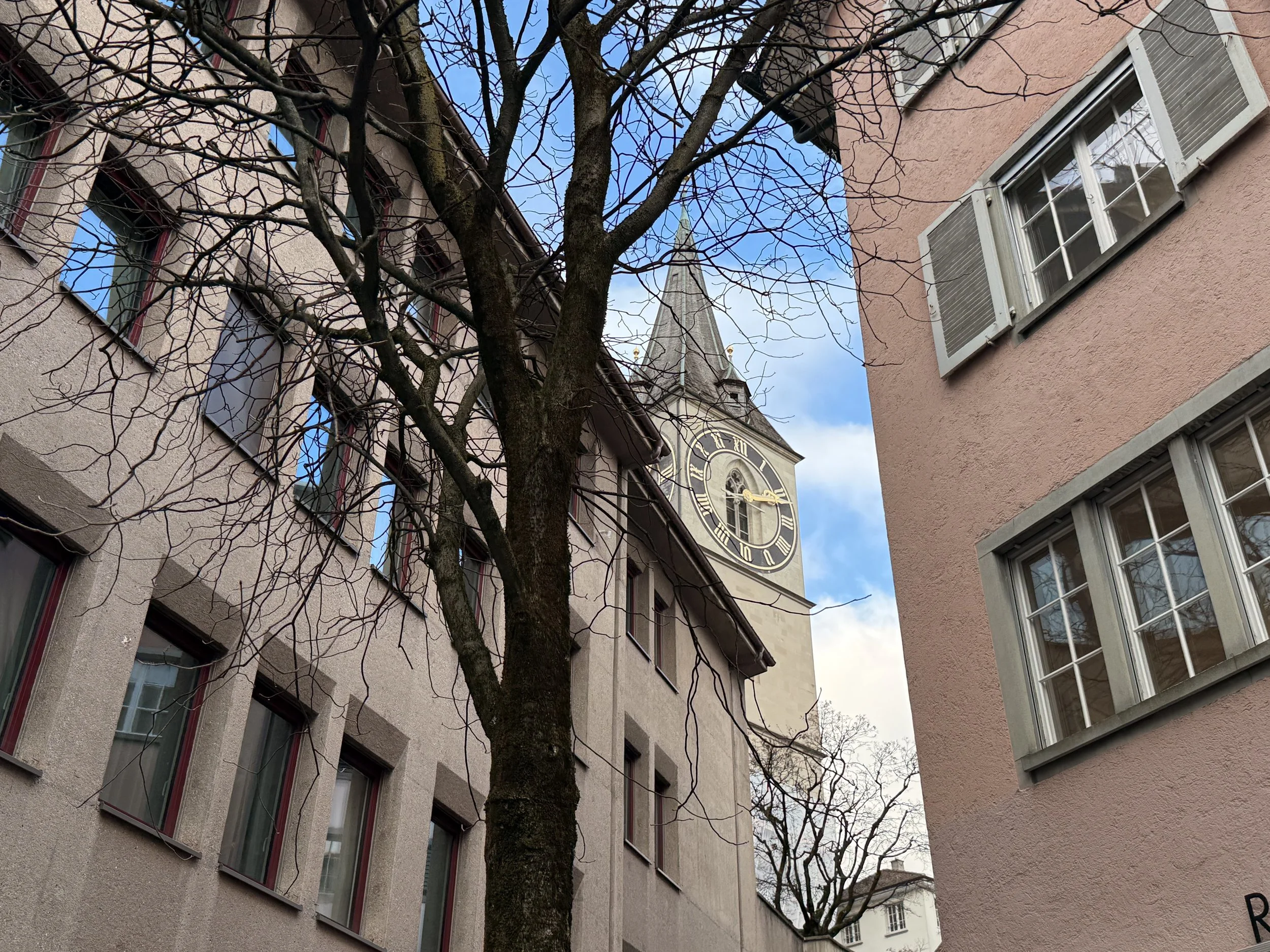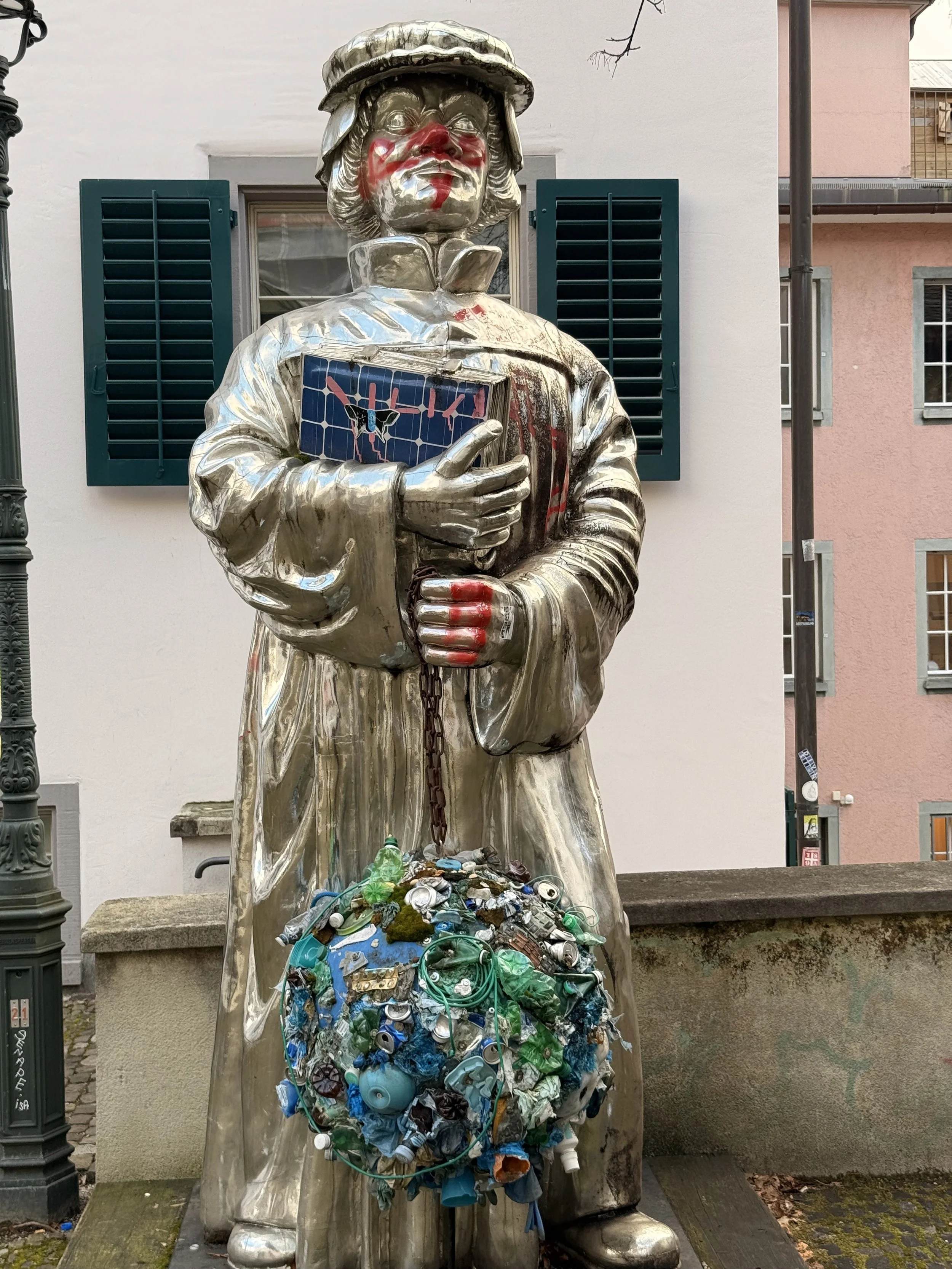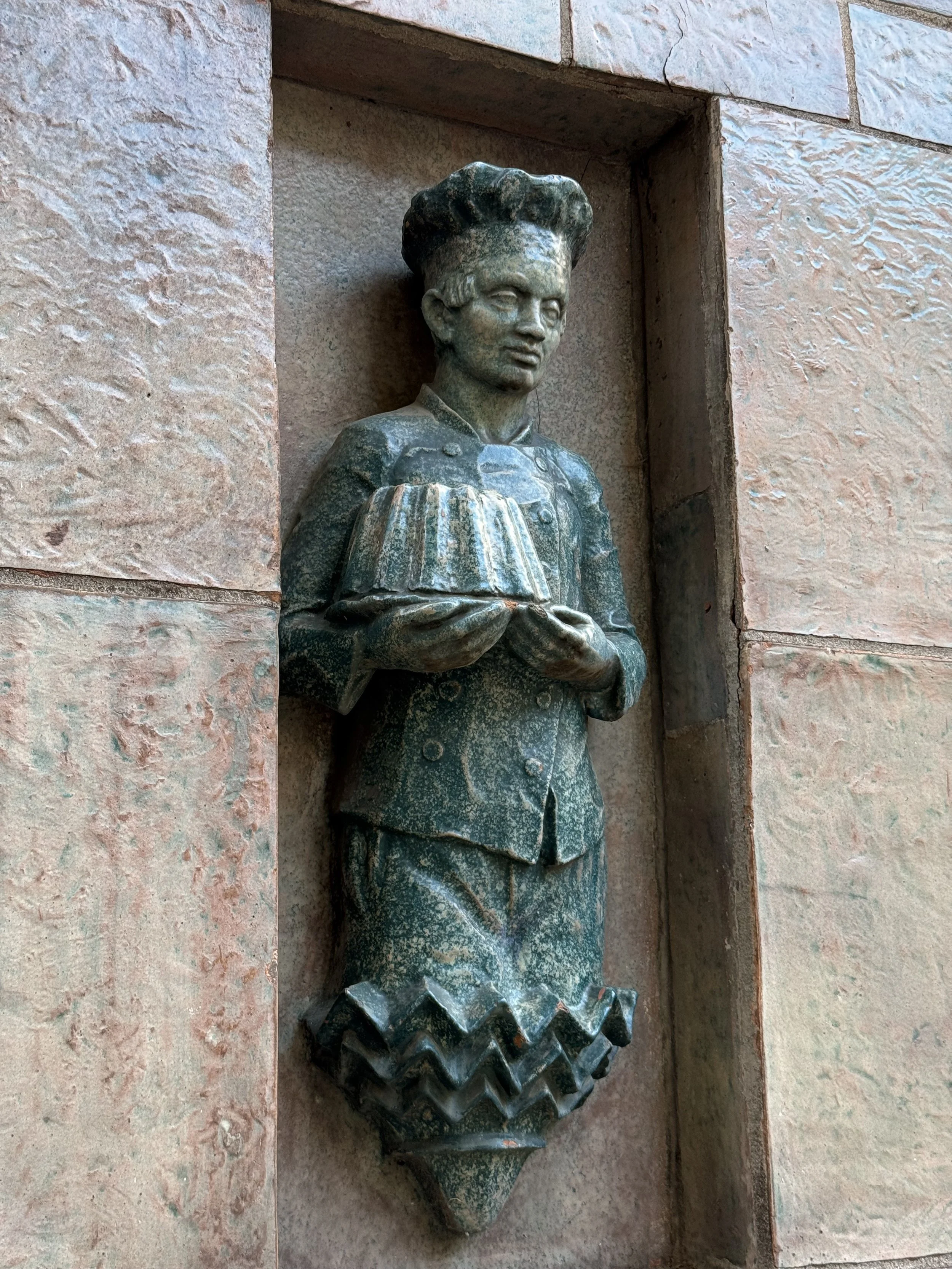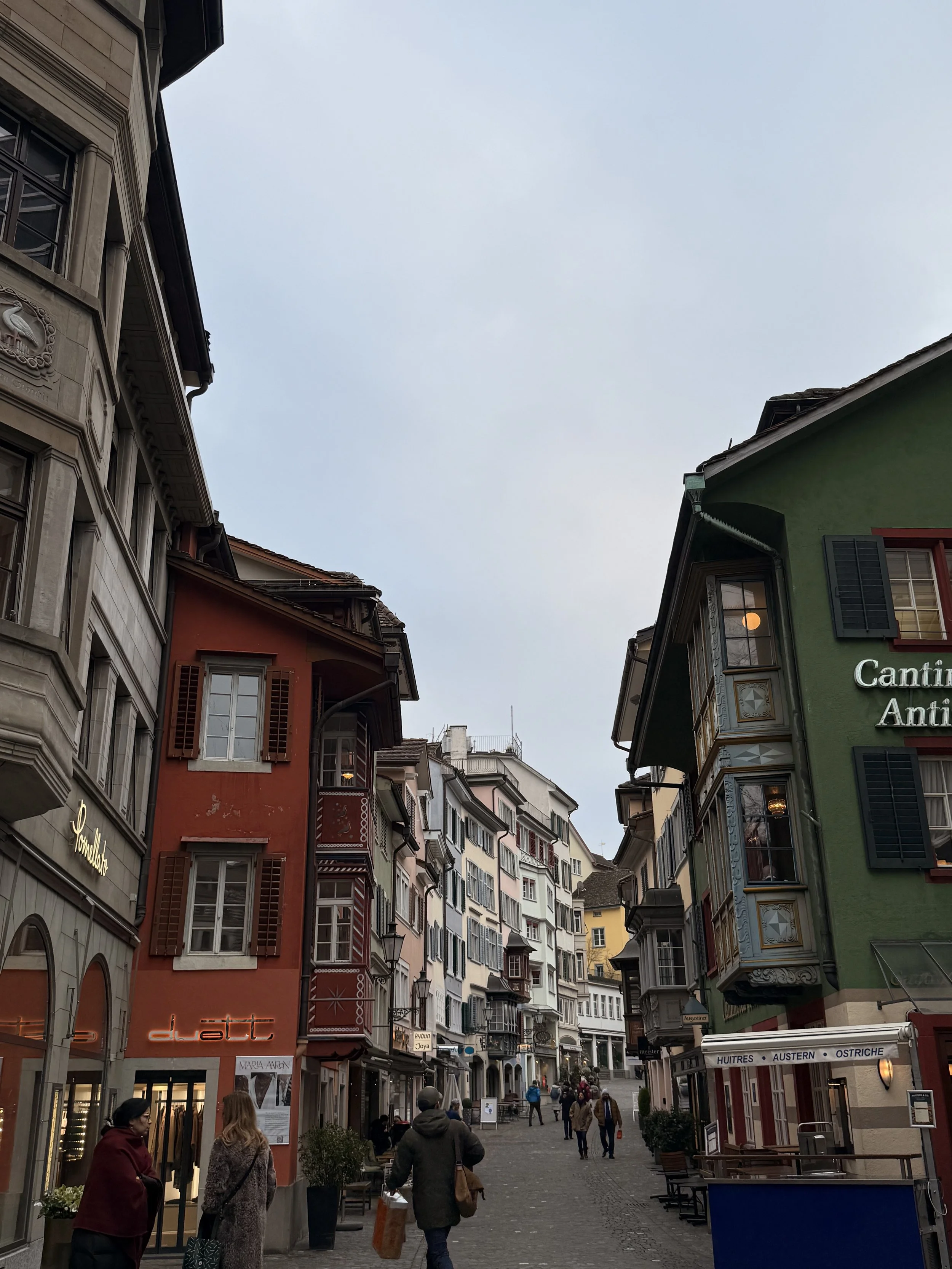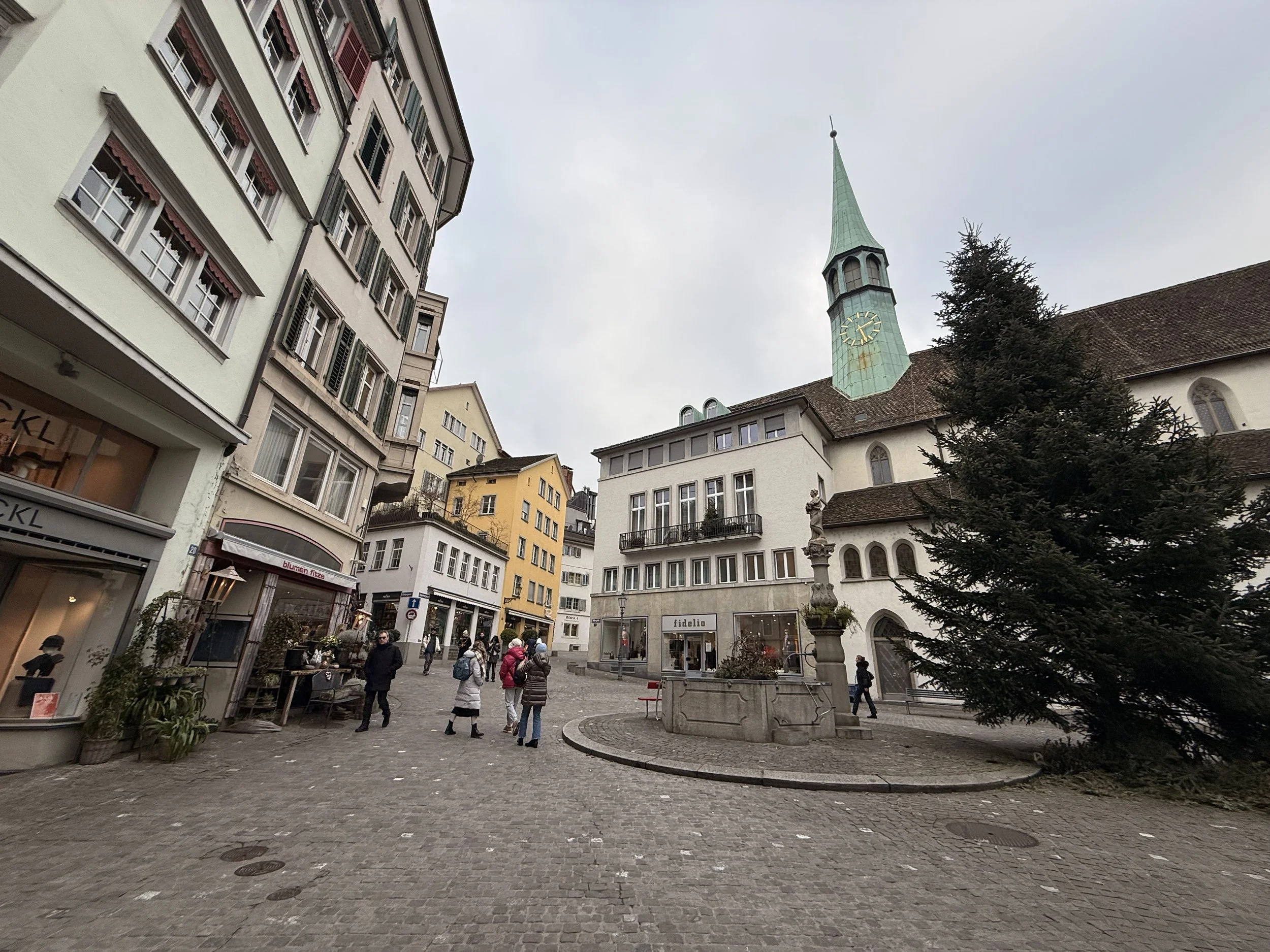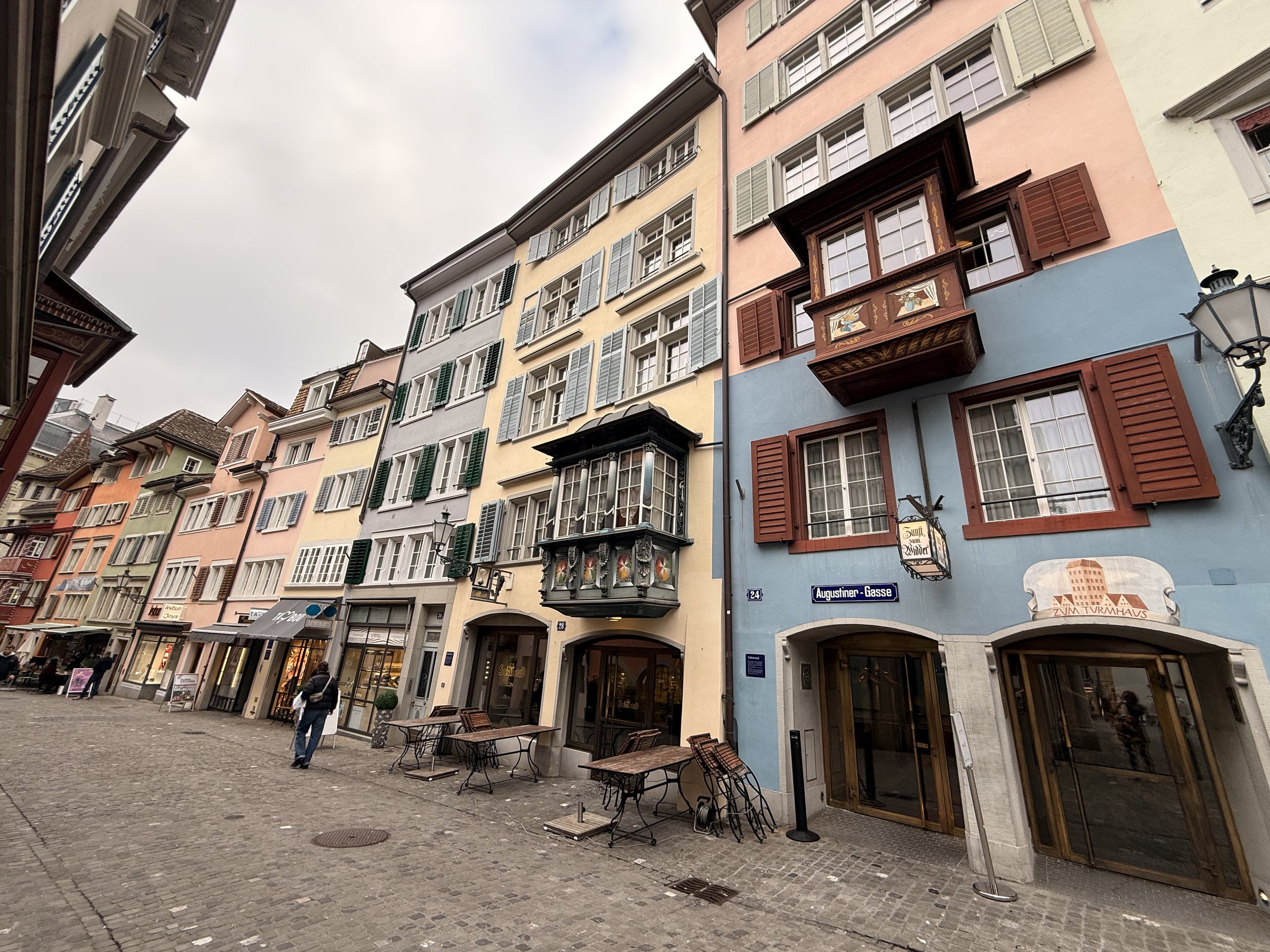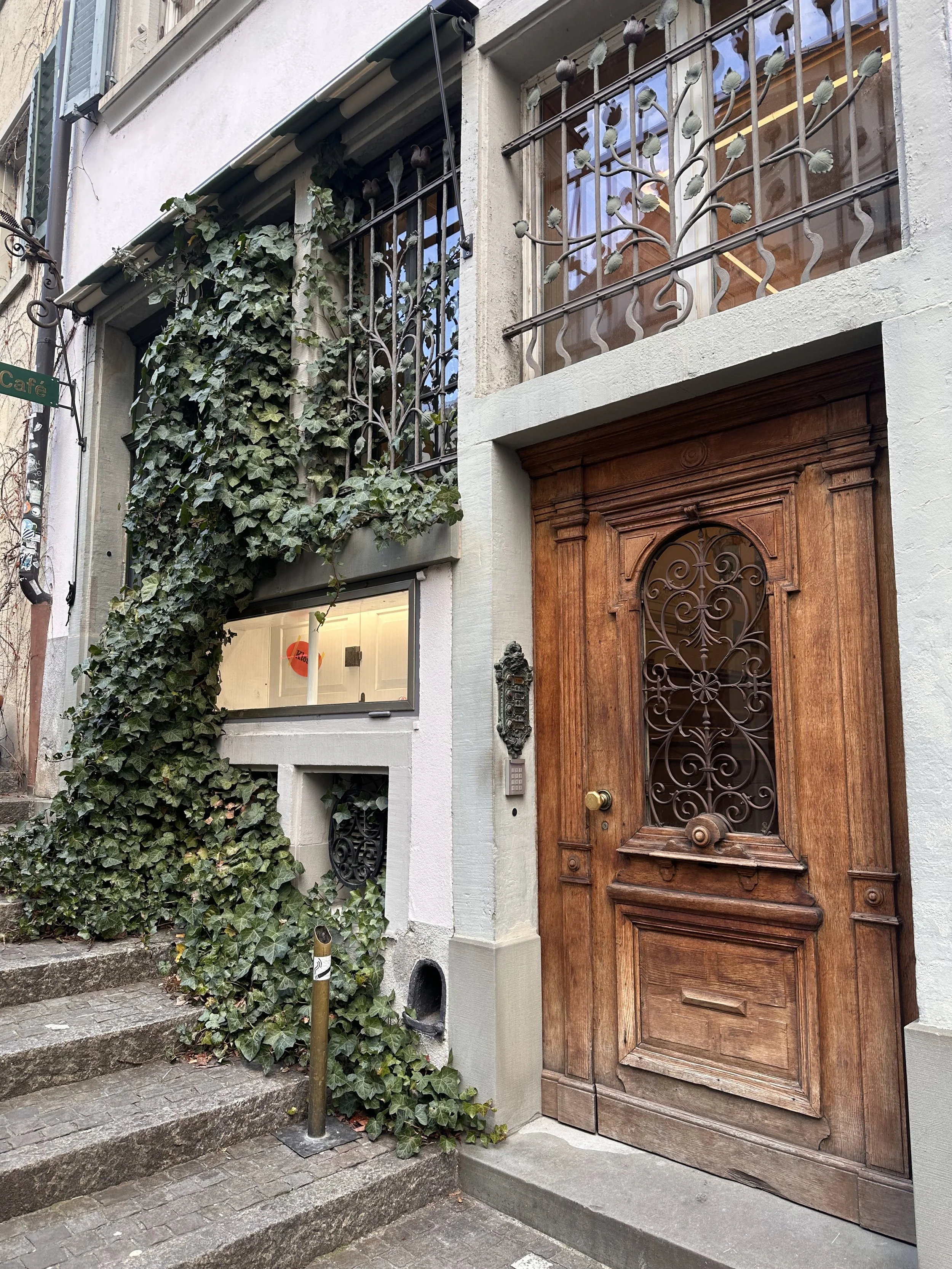Exploring Zürich, Switzerland
Zürich is one of those cities you hear a lot about, especially how costly it can be, think to visit one day, but it never makes the top of a bucket list. I’m here to tell you that, that should change.
The hustle and bustle of the city, itself, can be explored in just a couple of days, whether that’s for wandering the cobblestone streets of the old town, exploring one of their castle-like museums, or doing a little bit of shopping and dining. It’s also a great “anchor” for some amazing day trips (which feel endless) in and around the country!
The below information is a complete guide of the best places to stay, the top rated places to dine and drink, and all there is to see and do. We’ve also included transportation tips, as well as a summary of the history of this beautiful lively city!
Time needed in this city: 3 days - 1 week (depending on the number of day trips)
Jump To:
Where to Stay
Where to Dine & Drink
Things to See & Do
How to Get Around
A History Summary
Where to Stay
It’s interesting, the reviews on this hotel were hit or miss and we don’t understand why. Not only did we have a wonderful kitchen to cook meals in, but it was smack in the middle of a great town center, which includes a supermarket, movie theater, wine shop, bakery, florist, a mall, gym, and so much more.
Inside of the hotel, there is a fantastic bar/lounge that’s fairly busy on the weekend. The entire vibe is chic, luxe, and super comfortable with a lot of great spaces to work, relax, and enjoy.
Other Recommendations
Where to Dine & Drink
Modern Mediterranean menu served in an elegant room with chandeliers & white tablecloths.
Serving Mediterranean-inspired cuisine.
Modern & elegant restaurant with chandeliers serving new takes on classics, with extensive wines.
Classic Mediterranean fare, including seafood, pasta & wine, are served in this chic restaurant.
Black & white dining room with big windows & terrace, for imaginative cordon bleu & veal dishes.
A Michelin-starred restaurant serving classic Italian, French and internationally influenced cuisine
A Michelin-starred and Green Michelin-starred restaurant is located in the basement of a former silo on the Löwenbräu brewery site. The open kitchen delivers creative dishes with a focus on sustainability and seasonality, often using ingredients sourced from the immediate vicinity.
A Michelin-starred and Green Michelin-starred, using top-notch regional ingredients to create interesting, modern and creative dishes
A hip spot that follows the style of Japanese izakayas (casual bars that also serve food)
Serving fresh, southern Italian-inspired cuisine.
The oldest vegetarian restaurant in the world.
Gothic dining room in a 13th-century guild hall serving gourmet Swiss dishes, with outdoor tables.
Sophisticated restaurant with chic decor serving inventive Asian & Mediterranean cuisines.
IGNIV Zürich by Andreas Caminada
A two Michelin-starred restaurant, serving a set sharing menu.
Serving Mediterranean cuisine.
Gourmet regional cuisine in century-old restaurant, with art masterpieces lining wood-paneled walls.
A Michelin-starred hotel restaurant serving artfully plated Swiss dishes.
Homestyle cuisine in a traditional atmosphere, in the old town section of Zürich.
A Green Michelin-starred restaurant serving a modern menu of high-end vegetarian dishes.
A Micheline-starred restaurant showcasing creative vegan & vegetarian mains & desserts, plus a robust wine list.
The modern interiors of this traditional, chalet-style restaurant complement the updated Swiss food.
Swiss fare served in a tavern-like space that includes a room with names etched into the walls. UNIQUE TIP: After 6:00 p.m., visitors to the tavern are only permitted to drink water, grape juice, or wine. They host a drinking ritual known as balkenprobe, or “beam challenge”. To attempt the challenge, participants must find their way ceiling beam. Then, they crawl over to the adjacent rafter and hang upside-down. A waiter brings over a glass of white wine and the inverted guest then attempts to down the entire glass without spilling it.
Set in a traditional pub environment, Zurich’s newest Gastropub takes classic comfort dishes and elevates them with a touch of culinary flair.
Refined choice presenting pasta, grilled plates & other Italian fare, plus an ample wine list.
A Michelin-starred restaurant, serving classic Italian food & wine in a warm room with oil paintings.
Refined Mediterranean-inspired dishes & wine in a stylish Pierre-Yves Rochon-designed gazebo restaurant.
A green Michelin-starred, 19th-century restaurant offering artful, modern Swiss fare & local wines.
Located in the Kindli hotel, serving classic cuisine.
A Green Michelin-star restaurant serving modern seasonal dishes.
A two Michelin-star restaurant in an impressive building next to the main railway station, serving a cosmopolitan culinary concept. Per the Michelin Guide, “ In a relaxed, modern and elegant interior, diners take their seats on comfortable bar chairs at the eponymous counter right next to the open kitchen to observe the creation of a surprise menu of numerous exciting delicacies.”
Light & creative French-Mediterranean dishes, plus wines, are the focus of this tranquil restaurant.
A two Michelin-starred restaurant, located in the Widder hotel, bridges the gap between classic and modern cuisine, drawing on international influences.
Things to See & Do
Day Trips
Appenzell and Liechtenstein Tour from Zurich
Spend a day exploring Switzerland's eastern region and Liechtenstein when you book this private excursion from Zurich. Discover the charming town of Appenzell with its vibrant facades before venturing to Liechtenstein for a unique experience. Highlights include the majestic Mount Santis, Appenzell Cheese Dairy, Maestrani Chocolate Factory, and Liechtenstein's covered bridge over the Rhine.
Walk through one of Switzerland’s oldest villages—Appenzell
Learn about the Swiss chocolate- and cheesemaking traditions
Visit the longest-covered bridge in Europe over the Rhine
A private tour means a more personalized experience
Bern
For more information on our day trip there, click the link in the title!
Best of the Black Forest and Rhinefalls from Zurich
Although in Germany, the Black Forest lies just a 2-hour drive from Zurich. Discover it and some of Europe’s most majestic waterfalls on this private tour, direct from your hotel. See the Rhine Falls (Rheinfall), stroll along Lake Titisee, hike to the top of the 535-foot (163-meter) Triberger Falls, and explore the Black Forest town of Triberg: please note, all entrance fees are at your own expense.
Take a boat to the Rhine Falls and hike to the top of Triberger Falls
Explore Lake Titisee and the town of Triberg, home to museums and more
Private tour saves time and stress with no stops for other travelers
No need to navigate Zurich—picks up directly from your hotel
Boat Ride to RapperswiL-Jona
Rapperswil-Jona is known as the “town of roses” on Lake Zurich. While walking through the charming old town, visiting the castle, or strolling along the lakeside promenade, you’ll discover just what makes this town well worth visiting.
Cable car ride near Zurich
The Felsenegg cable car is just a 20-minute train ride away from Zurich main station. It’s a fun ride up the mountain to 2,625 ft., where you’ll get panorama views across the city, lake, and to the alps in the distance (on a clear day).
TIP: Take the five-minute walk through the forest to the restaurant - it has a big terrace overlooking the lake.
Grindelwald, Lauterbrunnen & Mürren Private Day Trip from Zurich
Tick off several Alpine highlights in just one day on this full-day tour of the Jungfrau Region, with hassle-free round-trip transfer from your Zurich hotel. Discover natural highlights and cultural landmarks including the Valley of 72 Waterfalls in Lauterbrunnen, a fairytale Alpine village in Mürren, and the iconic Swiss village of Grindelwald. Receive personalized attention from your private guide as you explore plus, enjoy an outdoor raclette experience in Gimmelwald.
Tick off three of the Jungfrau Region’s top attractions in just one day
Round-trip transfer from your hotel ensures a hassle-free journey
Benefit from your private guide’s personalized attention and insights
Enjoy an outdoor raclette dining experience included in the price
Jungfraujoch Exclusive Private Tour
A mountain kingdom of glaciers and eternal snow, Jungfraujoch is a must-visit for many. But piecing together many different trains and an aerial cableway can be a headache. On this tour, a private guide greets you at your hotel and accompanies you every step of the way. At the top, they’ll lead you round the ice palace and viewpoints so you don’t miss a thing.
Explore the Swiss Alps by train, cogwheel train, and aerial cableway
Capture epic photos of Alpine vistas and tumbling waterfalls
Private guide points out the best viewpoints and explains local culture
No need to navigate Zurich: Guide meets you in your hotel lobby
Luzern Elegance: Private City Walk and Lake Cruise from Zürich
Travel from Zurich to Lucerne by train with your own private guide, and learn as about the lakeside city as you go. Once there, you’ll take a stroll to hear the history behind Lucerne’s beautiful wooden Chapel Bridge and the medieval old town with its ancient towers and rampart walls. See the sights from the water during an audio-guided cruise on Lake Lucerne, then return to your Zurich hotel, accompanied the whole way by your guide.
Use the efficient Swiss trains to travel with ease from Zurich to Lucerne
Remove the hassle of day trip logistics by traveling with your own guide
Enjoy a bespoke tour of Lucerne that’s tailored to your personal interests
Cruise across Lake Lucerne with a prebooked ticket and audio guide
Mount Titlis (Private Tour)
Swap the bustle of the city for birds’-eye views of the Alps on this full-day private tour to Lucerne and Mt. Titlis from Zurich. Save time with hassle-free hotel pickup and drop-off, leaving you more time to explore Lucerne’s historic Old Town and soak up views of mountains, glaciers, and more from the top of Mt. Titlis, with return travel on the Rotair cable car included in the price.
See more of Switzerland on this full-day tour to Titlis and Lucerne
Enjoy the personalized service of a private tour
Explore Lucerne’s Old Town and ride to the summit of Mt. Titlis
Avoid hidden costs with hotel transfers and cable car rides included
Natural Wonders of Switzerland: Private Day Tour from Zurich
Discover breathtaking insider spots of Switzerland with a local Myswisspanorama guide - completely private
HIGHLIGHTS:
Guided by a highly educated local Swiss guide - 100% flexible
Learn interesting stories about life in Switzerland, our history, culture and much more
Explore beautiful hidden places and landscapes on a private day trip in Switzerland
Enjoy a delicious Swiss picnic with Raclette in a stunning landscape
If you wish, stop at a Swiss Luxury Chocolate and Mountain Cheese factory store
Pilatus Panorama: Exclusive Private Golden Round Trip from Zürich
Experience the famous Pilatus Golden Round Trip with ease on this full-day tour from Zurich. Start early with hassle-free transfer to Lucerne, leaving plenty of time for your lake cruise, cogwheel train trip, and gondola ride (season dependent), plus free time on the Pilatus summit. Enjoy the personalized service of a private tour and avoid hidden costs with all transport fees included.
Tick off the Pilatus Golden Round Trip on this full-day tour
Enjoy the personalized service of a private excursion
Benefit from your local guide’s advice and insights
Avoid hidden costs with all transport experiences included
Private Swiss Chocolate, Cheese, Mountain Santis Tour with Pickup
Experience Appenzell, a very traditional area of Switzerland on a full-day tour from Zurich. Explore the culture and traditions with an experienced tour guide.
Visit the Chocolarium of Maestrani and enjoy a one-hour sweet journey in the Interactive tour and sample the chocolate.
Try fine Swiss cheese at a traditional cheese factory, take a guided hike through the beautiful winter landscape and ride an aerial cable car to the top of Säntis Mountain. From here you have a wonderful view over the magnificent Swiss Alps.
Full-day cheese and chocolate tour to the Swiss mountains
Private tour, only your group will participate
Guided private tour to Appenzell in a luxury vehicle
Enjoy a chocolate tasting and interactive factory tour
Visit a cheese factory with cheese tasting
Take the aerial cable car up the mountain Säntis
Private Tour Bernese Alps - Steam Train & Lake Cruise from Zurich
Unique off the grid tour to the Swiss Alps with your private driver-guide. This tour shows you the best of the Alps, Lakes and Swiss country side in one day. If you prefer to avoid the common places, but still want to see Switzerland's highlights, then you should book this tour. We take you to a mountain with the best views over the Swiss Alps, and include a unique train ride by one of the few steam trains in Switzerland. This is the real Swiss experience, where common tours won't lead you (the place is not very well accessible by public transportation).
Private Trip - Zurich to Basel in Switzerland & Colmar in France
Check out culture-rich Basel in Switzerland and the city of Colmar in France on a private day trip from Zurich. Perfect for those who want to avoid the large, and sometimes impersonal, group tours, the bespoke experience is tailored to your interests to help you maximise your time in Basel and experience the Alsace region of France, too. Explore a renowned Basel museum or cruise on the River Rhine, then stroll around the architecture-rich city of Colmar, learning about its 16th-century houses as you go.
Rest your legs with door-to-door transport from your central Zurich hotel
Learn about the two countries from your personal driver-guide as you travel
Get Basel museum recommendations or see the sights from the River Rhine
Spend an afternoon in the French city of Colmar before returning to Zurich
The Vine Tour from Zurich (Private Tour)
Get a comprehensive taste of European culture and cuisine on this full-day tour from Zurich. Benefit from the insights of your expert guide as you explore Basel’s historic city, stop for photos by the Rhine, and sample cheese, wine, and champagne in France’s famous Alsace region. Enjoy the personalized service of a private tour and be free to indulge with hotel pickup and drop-off ensuring a hassle-free trip.
Explore Basel and the Alsace region on this full-day trip from Zurich
Savor complimentary samples of wine, cheese, and champagne
Receive personalized tips and attention from your private guide
Hotel pickup and drop-off ensures a hassle-free trip
Historical Exploration
Landesmuseum (Swiss National Museum)
Built in 1898, the museum’s building was built by Gustav Gull in the form of the French Renaissance city chateaus. His impressive architecture with dozens of towers, courts, and park on a peninsula, between the rivers Sihl and Limmat, has become one of the main sights of the Old Town district of Zurich.
The exhibition tour takes the visitor from prehistory through ancient times and the Middle Ages, to the 20th century. There is a very rich section with gothic art, chivalry, as well as a comprehensive collection of liturgical wooden sculptures, panel paintings and carved altars. There are also: a Collections Gallery, a place where Swiss furnishings are exhibited, an Armory Tower, a diorama of the Battle of Murten, and a Coin Cabinet showing 14th, 15th, 16th century Swiss coins and even some coins from the Middle Ages.
It’s a great way to spend a few hours.
Mühlerama Museum
For over 100 years, the Tiefenbrunnen industrial mill has been running in Mühlerama and still sells flour to this day.
For the price of the entry ticket, you not only get to learn more about the flour milling process, but also get a cup of wheat to grind through various historical grinders, including the the old-fashioned stone-on-stone method—the museum's stone is roughly 3,000 years old—to a modern hand-spun grinder. When you're done grinding, head upstairs and turn your handmade flour into freshly baked bread!
The museum also has a whole host of interactive and fun exhibits that tells the story of this mill, the machinery and mechanisms behind it, and interesting stories about food production, food waste, nutrition and more.
Münsterhof square
The oldest square in Zurich (dating back to at least 1st century AD, Münsterhof was, for centuries, the only proper square within the medieval town walls. From the Middle Ages onwards, it often served as a place to stage important political and cultural events for a larger audience. It is where the German king and his retenue was formally welcomed by the abbess of the Fraumünster abbey. She was also acting princess of the Holy German Empire and, up to the time of the Reformation in Zürich, the formal ruler of Zürich. The plaza probably became an open square around 1300 AD when the monastic graveyard was abandoned (except for the narrow strip beside the abbey). In medieval times, the bailiff's house of the Einsiedeln Abbey was also located at Münsterhof, and the plaza became the preferred domicile of the abbey's associates.
For centuries, it was the center of religious and political life. Today, it’s a great place to take in Medieval buildings and enjoy time outside.
Villa Patumbah
Erected in 1885, Villa Patumbah was built in a wild mixture of architectural styles. Different parts of the façade and interior combine elements of Italian Renaissance, Rococo, Swiss Chalet Style, and Southeast Asian folk art. The mansion, which is now a museum, is surrounded by a beautiful English-style garden.
Religious History
FraumÜnster cathedral
Fraumunster Cathedral was built on the remains of a former abbey for aristocratic women, which was founded in 853 AD, by Louis the German, for his daughter, Hildegard. He endowed the Benedictine convent with the lands of Zürich and granted the convent immunity, placing it under his direct authority. Today, it belongs to the Evangelical Reformed Church of the canton of Zürich and is one of the four main churches of Zürich, the others being the Grossmünster, Prediger and St. Peter's churches.
Grössmünster cathedral
The Grossmünster ("great minster") is a Romanesque-style Protestant church and is one of the four major churches in the city. Its congregation forms part of the Evangelical Reformed Church of the Canton of Zürich. The core of the present building, near the banks of the Limmat, was constructed on the site of a Carolingian church, which was, according to legend, originally commissioned by Charlemagne. Construction of the present structure commenced around 1100 and it was inaugurated around 1220.
The Grossmünster was a monastery church, vying for precedence with the Fraumünster across the Limmat throughout the Middle Ages. According to legend, the Grossmünster was founded by Charlemagne, whose horse fell to its knees over the tombs of Felix, Regula and Exuperantius, Zürich's patron saints. The legend helps support a claim of seniority over the Fraumünster, which was founded by Louis the German, Charlemagne's grandson. Recent archaeological evidence confirms the presence of a Roman burial ground at the site.
St. Peter’s Church
St. Peter’s Church was built on the site of a temple to Jupiter - it’s earlier church of 10 X 7 meters is archaeologically attested for the 8th or 9th century. Around 1000 AD, it was then replaced by an early Romanesque church, then replaced again in 1230 by a late Romanesque structure, parts of which survive. The nave was rebuilt in 1460 in the Gothic style.
The current building was consecrated in 1706 as the first church built under Protestant rule. Its congregation forms part of the Evangelical Reformed Church of the Canton of Zürich. The bells were installed in 1880 and until 1911, the steeple was manned by a fire watch. Restoration work was carried out in 1970 to 1975.
The church steeple is owned by the City of Zürich, while the nave is owned by the St. Peter parish of the Evangelical Reformed Church of the Canton of Zürich.
NOTE: When we went in January 2025, it was closed for renovations.
The Arts & Sciences
Bambibrunnen (Bambi Fountain)
Bambi, a Life in the Woods was first published as a children’s novel by the Austrian author Felix Salten in 1923. As a renowned journalist and active member of the literary world, Salten wrote many books, opera-librettos, and theater plays.
In 1933, he sold the film rights for Bambi to Walt Disney for only $1,000. After 1936, his books were prohibited in Germany after 1936 (his main market), due to him being Jewish. When Germany annexed Austria, Salten’s daughter helped him emigrate to Switzerland, though he was not allowed to participate in any journalistic activities. He died in 1945.
The Bambibrunnen has stood in its place since it was erected by Swiss stonemason, Arnold Huggle. In 1950, a plaque was added, describing its connection to Bambi and Salten.
Helmhaus
The Helmhaus is a cultural institution run by the City of Zurich. It is housed in a historical building in the heart of the old city, where it shows 4-5 exhibitions per year, usually around social challenges. It has been the only art institution in Zurich to be dedicated primarily to local contemporary art. The Helmhaus generally provide financial support for such new works, and the 100-150 artists (annually that exhibit) receive a fee for their contributions to its shows.
Kunsthaus (Zürich art museum)
Kunsthaus is the biggest art museum of Switzerland and houses one of the most important art collections in Switzerland. The collection spans from the Middle Ages to contemporary art, with an emphasis on Swiss art. Built in 1910, it has been expanded four times.
Museum für Gestaltung
This museum has four collections - design, graphics, applied arts, and posters , containing over 500,000 objects of aesthetic and technical development, in total.
Schrödinger's Cat
In 1935, Austrian physicist Erwin Schrödinger came up with the infamous thought experiment known as, “Schrödinger's Cat”. It consists of three items sealed inside a box: a cat, a flask of poison, and a radioactive source. Should the internal Geiger counter detect radioactivity, the contraption would break the flask open, releasing the poison. According to the Copenhagen interpretation, the cat would be simultaneously alive and dead at this point and remain in this state until the box is opened.
Today, in the garden of Schrödinger's former house at Huttenstrasse 9 in Zurich, a life-size figure of a cat can be found. Depending on the light conditions of the day, it may appear alive or dead, just like the famous thought experiment.
Urania observatory
It’s odd that there would be an observatory in the middle of the city, but the Urania Observatory’s origins explain why. In 1759, so called “Astronomische Kommission” (Astronomy Commission) built an observatory from this location to be able to calculate the exact global location of the city of Zurich. In later years, astronomical observations were done from the Grossmünster's southern "Karl's tower", followed by scientific observations from the Federal observatory, built in 181 - 1864 for ETH Zurich by Gottfried Semper.
In 1899, the Zurich merchant, Abraham Weill Einstein, initiated the oldest observatory in Switzerland, situated near Werdmühleplatz (Uraniastrasse). On June 15, 1907, the observatory was given to operational use.
The observatory offers guided tours of the Moon, Solar System objects, stars, star clusters, interstellar clouds, and galaxies. Paid public tours can be found on clear weather from Tuesday to Friday, starting at 8pm. Unfortunately, light pollution allows restricted observations of a few galaxies and nebulae., as well as the moon and planets, and bright celestial objects.
Zürich Tram Museum
The Zurich Tram Museum is a transport museum, specializing in the history of the Zurich tram system. The main museum site is located at the former tram depot, Tramdepot Burgwies and is run by an association, the Verein Tram Museum Zürich, which has some 500 members, and is responsible for looking after the exhibits of the museum. The tram cars remain in the ownership of the Verkehrsbetriebe Zürich, the city-owned operator of the Zürich tram system.
Zürich Zoo
Opened in 1929, it is the third oldest zoo in Switzerland. It houses a collection of 2,200 specimens of 300 species. It continues to evolve and expand.
TIP: One of its popular events is the penguin parade, which is performed daily after 12pm if the outside temperature is below 10 degrees Celsius (50 degrees Farenheit).
Unique Experiences
Cabaret Voltaire: the Dada House
Cabaret Voltaire is the birthplace of the Dada art movement, founded in 1916. It was founded by Hugo Ball and Emmy Hennings as a cabaret intended for artistic and political purposes. It shuttered in the summer of that same year.
After the turn of the millennium, the building that housed Cabaret Voltaire in 1916 had fallen into disrepair, and in the winter of 2001-2002, a group of artists describing themselves as neo-Dadaists, organized by Mark Divo, squatted the building to protest its planned closure. Over a period of three months there was a number of performances, parties, poetry evenings and film nights, attended by thousands. They declared that it was a signal for a new generation of artists to align themselves with a revival of Dada. That spring, the occupants were arrested.
Since 2008, it has been operating as a museum, bar and cultural space and is open to the public.
FIFA Museum
Opened in 2016, the FIFA Museum is a mind-blowing 38,000 sq. ft. (over three floors) of over 1,000 artifacts, since the inception of the sport. These include memorabilia from every FIFA World Cup and FIFA Women's World Cup, the most famous one being the original FIFA World Cup Trophy. The exhibition features various interactive and multimedia installations such as the biggest pinball machine ever made and an audiovisual media installation called Visions of Football using 26 ft. LED screens.
It also has a store, cafe, bar, and library.
TIP: It’s great for the whole family! They have a huge kids play area with all sorts of fun drills they can do.
Flumserberg FLOOMZER summer toboggan
Across a distance of 1 1/4 miles and 820 ft. of elevation loss, action fans race through the Swiss mountains at up to 24 MPH. Tunnels, curves, bridges, waves and 360-degree circles provide a lot of variety. As a “bonus”, you’ll always have a breathtaking view of the Swiss mountains while summer tobogganing on Flumserberg.
NOTE: This is about 90 minutes, by train, outside of Zurich.
Hürlimannbad & Spa
At the Hürlimannbad & Spa Zurich, you bathe in century-old vaults that offer peace and relaxation. The thermal bath area has been redesigned and refurbished in 2022. Their rooftop infinity pool offers a amazing panoramic views over Zurich.
TIP: Do the Roman-Irish spa ritual, which combines ancient bathing cultures into a unique, ten-station cleansing ritual.
Limmat River Cruise (and other boat tours)
With so many waterways, taking a boat cruise is a great way to see the city! Click on the link in the title to learn which options/dates/times are available.
Lindt Home of Chocolate
No trip to Zürich is complete without a tour of one of the most well-known chocolate-makers in the world! Book your tickets in advance to tour the history of chocolate, learn the process of how it’s made, taste some of the different flavors Lindt makes, and of course, shop their massive store! If you’re so inclined, you can also book chocolate-making classes.
NOTE: It is a bit of a train ride from city centre, so be sure to give yourself plenty of time to get there.
Polybahn UBS funicular train
Serving Zürich since 1886, the Polybahn UBS funicular train is now considered a great tourist attraction with beautiful views. It costs about $1.30 to ride and is completely automated (since 1996). It takes about 100 seconds from Central to Polyterrasse, and is the shortest route from Limmatquai to the University of Zurich and the Swiss Federal Institute of Technology (ETH).
FUN FACT: Einstein used to use it to get to/from the university!
Swiss Finance Museum
The first and only financial museum in Switzerland that explains the origins of the economic system and the role of the stock market. Find out all there is to know about the Swiss financial market and experience economic history and modern innovations in a way that is entertaining and uses a variety of different media.
Walking Tours
Lake Zurich Promenade
Lake Zurich was once above all a transport route. Today, it is a popular excursion point for swimming, boating or having a picnic on the lake's banks.
Lindenhof Park
Lindenhof was largely surrounded by water until the early medieval area, which made it an optimal location for early fortified settlements. Archaeologists found remains of a Celtic Oppidum from the 1st century BC and artifacts, dating to 1500 BC, near the Limmat River.
In 15 BC, Augustus's stepsons, Drusus and Tiberius, integrated the territory on the left side of Lake Zurich into the Roman provinces, Raetia and Germania Superior. Several stone buildings from the Roman period were located on and around the hill. It was part of the small vicus Turicum, located on both sides of the Limmat and connected by a Roman bridge located near the present Rathausbrücke.
Using the topography, the Roman military built a citadel on top of the hill in the years of the Roman emperor Valentinian I (364–375) to defend migrations from the North by the Alamanni. It was 4500 sq. meter large and was fitted with 10 towers and two meter-wide walls.
During the Middle Ages, the hilltop leveled fort became the retaining wall and gave the Lindenhof terrace a shape similar to its current one.
Following the demolition of the former royal residence in 1774, the hill—the only public park within the city walls—became an area for public life and relaxation, with dense tree vegetation, stone tables, crossbow stands, and bowling and chess; the latter are still very popular in modern times.
Niederdorf Neighborhood
The Niederdorf district refers to an area in Zürich's old town across and along the Limmat river. It is known as being a main destination for the city's nightlife, as well as many shops and alleyways.
How to Get Around
Taxis
You can order taxis however, they are one of the most expensive ways to get around the city - especially if you’re coming from the airport. If you order a taxi from there, it will nearly 130 - 180 euro!
Rideshare
There isn’t much need for a rideshare unless you have more luggage than you care to lug on and off trains/trams. If that’s the case, rideshares are certainly cost-effective, compared to a taxi. It was about 45 euro, one way, from the airport to our hotel, which was about 30 minutes away.
Tram/Train
The public transport in Zürich is phenomenal and is the primary way everyone gets around, both inside and outside of the city. Download the SBB Mobile app to start and set up your account.
SBB Mobile App Tips:
Easy Ride is GREAT if you keep your cell service on. Swipe once to start the ride once you’re on the tram/train and once at the end to end the ride. Otherwise, you will have to get paper tickets for each ride you take, at one of their kiosks at the stops or get day passes - those can be costly.
You can get the Swiss Pass to access all the museums, rides you need to take, etc. however, we didn’t find it worth the hefty price tag, since we wouldn’t have taken full advantage of that offer. Do the math first before agreeing to sign up for it.
If you are on a train, heading to another town or city in Switzerland, click on the easy ride icon and then the little QR code on that page. It will generate a QR ticket that the porter will scan.
Easy ride will have a first and second class selection. There is no first class on trams, only trains, so that selection doesn’t matter for inter-city travel. For trains, make sure you are heading to the right car and select the right class.
Bikes and eScooters
Some people prefer to bike around town with bike lanes aplenty to do so. SBB also rents both bikes and eScooters to get around.
Car Rental
If you plan on taking a driving tour of Switzerland, note that renting a car, parking, and gas are very expensive in this country. Take a look at all train and bus routes before choosing this mode to get around.
A History Summary
200 BC - There is evidence of Celtic Helvetian inhabitants in the area that is now Zürich.
90 AD - The Roman Vicus Turicum (Gallo-Roman settlement) first belonged to the province of Gallia Belgica, and to Germania superior.
318 AD - Constantine’s reform of the Empire shifted the border between the praetorian prefectures of Gaul and Italy, was now just east of Turicum, crossing the Linth between Lake Zurich and Walensee. It was not fortified, but there was a small garrison at the tax-collecting point, set up downstream of Lake Zurich, where the goods entering Gaul were loaded onto larger ships. South of the castle, at the location of the St. Peter church, a temple to Jupiter was erected.
2nd century - The earliest mention of the town’s name was found on a tombstone in this century.
4th century - The town was Christianized.
5th century - The Alamanni settled in the Swiss plateau.
8th century - Zurich was part of Frankish-ruled Alemannia, starting in 746.
9th century - In 853, a Carolingian castle, built on the site of the now ruined Roman castle, by the grandson of Charlemagne, Louis the German. Louis also founded the Fraumünster abbey for his daughter Hildegard. He endowed the Benedictine convent with the lands of Zurich, Uri, and the Albis forest, and granted the convent immunity, placing it under his direct authority. Zurich gradually acquired the characteristics of a medieval city. It was now the center of the separate county of Zürichgau, detached from the older county of Thurgau. The early city was dominated by the Fraumünster convent.
10th century - A wall was built around the four settlements to safeguard against Saracen marauders and feudal barons.
1045 - King Henry III granted the convent the right to hold markets, collect tolls, and mint coins, and thus effectively made the abbess the ruler of the city.
12th and 13th centuries - Trade (and the medieval town) flourished with the introduction silk trade from Italy.
1218 - Zurich was in direct control of the emperor after the extinction of the main line of the Zähringer family. It became a free imperial city under the nominal rule of a distant sovereign.
1231 - Predigerkirche was built as a Romanesque church of the then Dominican Predigerkloster nearby the Neumarkt and the city's hospital.
1234 - Emperor Frederick II promoted the abbess of the Fraumünster to the rank of a duchess in 1234. The abbess assigned the mayor, and she frequently delegated the minting of coins to citizens of the city.
1273 - The first official mention of the Jewish population occurred in this year and a Jewish synagogue was built sometime during the latter part of that century.
1315 - The men of Zurich fought against the Swiss Confederates at the Battle of Morgarten.
1336 - The beginning of self-government came with the establishment of the Zunftordnung (guild laws) by Rudolf Brun. A Guild was formed with some 200 wealthy members, who expelled the Jews from the Guilds, citing they were for Christians only.
1348 - 1349 - When the Black Death epidemic came to Switzerland, the Jews were widely accused of having poisoned wells. On February 24, 1349, the city's Jews were tortured, burned, and driven out of Zurich. It wasn’t until 1354 they began to resettle in the town.
1351 - Zurich joined the Swiss confederation (which at that point was a loose confederation of de facto independent states) as the fifth member.
Early 1400s - A 1404 law forbade Jews from testifying against Christians in court and in 1423, they were indefinitely expelled from the city.
1436 - 1450 - The Old Zurich War took place
1440 - 1450 - Zurich was expelled from the confederation in 1440, due to a war with the other member states over the territory of Toggenburg (the Old Zurich War). Zurich was defeated in 1446, and re-admitted to the confederation in 1450.
1460 - 1519 - Zurich managed to substantially increase the territory under its control, gaining the Thurgau (1460), Winterthur (1467), Stein am Rhein (1459/84) and Eglisau (1496). From 1468 to 1519, Zurich was the Vorort of the Federal Diet.
1498 - In the constitution of 1498, the patricians became the first of the guilds, and which remained in force till 1798. Some special rights were also given to the subjects in country districts.
16th and 17th centuries - The patriciate and council of Zurich adopted an increasingly aristocratic and isolationist attitude. A sign of this was the second ring of expansive city ramparts that was built in 1642 under the impression of the Thirty Years' War.
1524 - The Augustiner and Prediger monasteries and Oetenbach nunnery and Rüti Monastery nearby Rapperswil were also disestablished. The aftermath of the Reformation in Zurich resulted also in the abolishment of the Zurich convent, the worship in the churches were discontinued, and the buildings and income of the monasteries were assigned to an according Amt, a bailiwick of administratively function of the city's government.
1531 - Ulrich Zwingli’s Bible first appeared in this year and is continued to be revised until the present day.
1648 - The town changed its status to a “republic”.
1650 - 9,000 privileged burghers was 9000 ruled over 170,000 persons.
1798 - The old system of government perished in Zurich, as elsewhere in Switzerland, with the French invasion in the spring of this year. Under the Helvetic constitution, the country districts obtained political liberty.
1799 - The city became a “battlefield” during the French Revolutionary Wars of the Second Coalition, at the First Battle of Zurich in June and the Second Battle of Zurich in September. Gottfried Keller became an intellectual influence on the Radical "free-thinking" side in the formation of Switzerland as a federal state.
1823 - 1859 - The Limmatquai was built in several stages.
1830 - 1831 - Improper balance of council members led to a new constitution.
1833 - The University of Zürich was founded.
1839-1840 - The city had to yield to the demands of its rural subjects. Ramparts were torn down as a result and it then became the Federal capital for one year.
1845 - 1846 - Zurich was the federal capital for a second time.
1847 - 1871 - The Spanisch-Brötli-Bahn, the first railway on Swiss territory, connected Zurich with Baden, putting the Zürich Hauptbahnhof at the origin of the Swiss rail network. The present building of the Hauptbahnhof dates to 1871.
1855 - The Swiss Federal Institute of Technology was founded.
1860 - Town schools, opened to "settlers" only on paying high fees, were made accessible to all.
1862 - Jews were given full legal and political equality, and that same year, the Israelitische Cultusgemeinde Zürich was founded.
1875 - Ten years' residence ipso facto conferred the right of burghership.
End of 19th century - Zürich had become Switzerland’s financial and economic center.
1887 - With the construction of the new lake front, Zurich was transformed from the medieval small town on the Limmat and Sihl to an attractive modern city.
1893 - The city was extended to include the (former) villages of Wollishofen, Enge, Leimbach, Wiedikon, Wipkingen, Fluntern and Hottingen, and the then-recently built-up areas of Aussersihl (formerly part of Wiedikon), Oberstrass, Unterstrass, Riesbach and Hirslanden.
1916 - The Dada art movement was born.
1933 - The central committee for refugee aid was created.
1934 - the city borders were again extended, to the inclusion of the former villages, by that time de facto suburbs, of Albisrieden, Altstetten, Höngg, Affoltern, Seebach, Oerlikon, Schwamendingen and Witikon.
WWII - Zurich was accidentally bombed.
Post WWII - 1960s - An economic boom took place.
Second half of the 20th century - Production of machines became dominant, as well as banks and insurance companies.
1968 - The London Gold Exchange closed, which prompted the Zurich banks to found the Zürich Gold Pool, a gold trading organization, which helped establish Zürich as one of the most important trading places for gold worldwide.
1980s - 1992 - The city entered its “youth rebellion” era, which included periodic protests and high drug use. In fact, Platzspitz, a public park behind the main railway station, became infamously known as “Needle Park” and was closed in 1992.
1990s - The introduction of liberal laws favored the development of Zurich's role as the regional center of nightlife. And, the liberalization of zoning laws led to a renewal of construction activity. The S-Bahn was also introduced to ease commuting congestion into and out of the city. Also, by the mid-1990s, an emphasis on therapy and treatment, rather than drug policing and prevention, had begun showing significant positive results.
1998 - The two largest Swiss banks, Credit Suisse Group and UBS AG, agreed to pay two billion Swiss francs to international Jewish organizations. This was due to the banks taking advantage of banking secrecy laws to help the Nazi Party launder gold and stolen valuables during WWII.
2001 - The finance economy was deeply shaken with the U.S. attacks on 9/11. Zürich-based Swiss Air Transport Company Ltd. (Swissair) collapsed. It would go onto be restructured and recover the following year.

